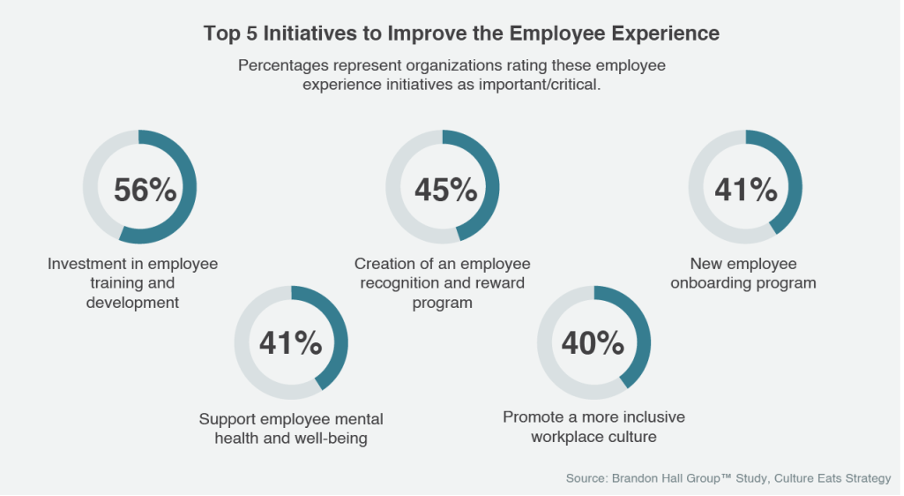
Organizations that prioritize learning and development gain a significant advantage. Creating a learning culture is a strategic investment that unlocks workforce potential and drives organizational transformation. EI Powered by MPS, a Brandon Hall Group™ Smartchoice© Preferred Provider, has proven this time and again in their work helping clients unlock powerful learning strategies.
Learning Culture: The Key to Organizational Success
Organizations with a robust learning culture are more agile, innovative and resilient. They can quickly adapt to market shifts, technological advancements, and changing customer demands. Employees in these organizations are encouraged to explore new ideas, experiment, and take calculated risks, fostering innovation and empowerment. The connection between learning strategy and employee engagement, job satisfaction, and organizational performance is strong. When employees feel supported in their professional development, they are more likely to be engaged, satisfied, and committed to the organization’s success, leading to improved productivity and creativity.
Fostering a Learning Mindset: Strategies for Organizations
To foster a learning mindset, organizations should implement several key strategies. First, establish a shared vision that underscores the significance of learning and growth for both the organization and its employees. Foster a growth mindset by cultivating an environment that values curiosity, experimentation, and resilience, encouraging the view that mistakes are opportunities for learning and growth. Integrate learning into the daily workflow by making it a habitual part of the workday and providing access to resources such as industry publications, workshops, and online courses. Cultivate a supportive climate where curiosity is embraced, feedback is sought, and errors are viewed as growth opportunities. Finally, recognize and reward learning by establishing systems to acknowledge and reward employees who demonstrate commitment to learning and self-improvement.
The Role of Leadership in Cultivating a Learning Environment
Leaders play a crucial role in fostering a learning culture. They must articulate the value of skill enhancement for personal and organizational success, demonstrate a passion for learning by seeking new knowledge and sharing their learning journeys, ensure employees have access to various learning resources and opportunities, encourage self-directed learning to create a highly skilled and adaptable workforce, and recognize and celebrate learning achievements to motivate continuous growth.
Building an Inclusive Learning Culture: Embracing Diversity and Accessibility
To maximize the benefits of a learning strategy, organizations must prioritize inclusivity and accessibility. This involves ensuring equal access to learning opportunities for all employees, adapting learning content and delivery methods to accommodate diverse learning styles and needs, promoting diversity in mentorship and leadership development programs, and addressing unconscious biases in learning and development processes.
Impact of AI on Continuous Learning and Cultural Development
Artificial intelligence is revolutionizing organizational approaches to continuous learning and cultural development. This transformative technology is reshaping how employees acquire knowledge, develop skills, and engage with learning content.
AI-enabled learning platforms are at the forefront of this change, offering personalized and adaptive learning experiences tailored to individual needs and preferences. These platforms use sophisticated algorithms to analyze learner data, identify knowledge gaps, and recommend relevant content. By adapting to each learner’s pace, style, and proficiency level, AI ensures that learning is both efficient and effective. For instance, if a learner struggles with a particular concept, the AI can provide additional explanations or practice exercises, while allowing more advanced learners to progress faster through familiar material.
AI chatbots and virtual assistants have become invaluable tools in supporting continuous learning. These intelligent systems provide real-time support and guidance to learners, answering questions, clarifying concepts, and offering immediate feedback. Available 24/7, they serve as virtual mentors, helping learners navigate their educational journey and ensuring they have the support they need to succeed. This instant access to assistance can significantly enhance the learning experience and improve knowledge retention.
The power of AI-driven analytics is transforming how organizations approach learning and development strategies. These analytics provide deep insights into learner progress, skill gaps, and the effectiveness of training programs. By leveraging this data, organizations can identify areas for improvement and tailor their learning strategies to ensure employees receive the most impactful and relevant training. For example, AI can analyze performance data across the organization to identify skills that are in high demand or areas where employees are struggling, allowing for targeted learning interventions.
The integration of AI with virtual reality (VR) and augmented reality (AR) technologies is creating immersive and highly engaging learning environments. These technologies allow learners to practice skills in realistic, simulated scenarios without real-world risks. For instance, a surgeon could practice a complex procedure in VR, or a technician could receive AR-guided instructions while repairing equipment. AI enhances these experiences by adapting the scenarios in real-time based on the learner’s actions and decisions, providing a truly interactive and personalized learning experience.
Furthermore, AI is facilitating more effective knowledge sharing and collaboration within organizations. Intelligent systems can connect employees with similar learning goals or complementary skills, fostering peer-to-peer learning and cross-functional collaboration. AI can also help curate and distribute user-generated content, allowing organizations to tap into the collective knowledge of their workforce more effectively.
As AI continues to evolve, its impact on learning and development is likely to grow even more profound. Emerging technologies like natural language processing and emotion recognition could further personalize the learning experience, adapting not just to a learner’s cognitive needs but also to their emotional state and motivation levels.
However, it’s important to note that while AI offers tremendous benefits, it should be seen as a tool to enhance human learning rather than replace human interaction entirely. The most effective learning cultures will likely be those that strike a balance between AI-driven personalization and the irreplaceable elements of human mentorship, collaboration, and shared experience.
Measuring the Impact of a Learning Culture
To demonstrate the benefits of a learning strategy, organizations should measure its impact through various metrics. Learning cultures lead to faster problem resolution and improved decision-making. Upskilling the workforce can drive revenue growth, reduce turnover costs, and attract top talent. Learning-focused organizations are better equipped to adapt to change and seize new opportunities. Supported employees experience greater personal and professional satisfaction, leading to improved retention and skill development.
Creating a strong learning culture is essential for organizations seeking to thrive in today’s evolving business landscape. By fostering a growth mindset, integrating learning into daily workflows, and leveraging technologies like AI, organizations can cultivate an environment that values continuous learning and personal growth. This approach not only enhances employee engagement and satisfaction but also drives innovation, adaptability, and overall organizational success. As the business world continues to evolve, those organizations that prioritize learning and development will be best positioned to lead the way in innovation, employee satisfaction, and long-term success.
To learn more about the ways EI by MPS helps companies craft sustainable and effective learning strategies and cultures, visit them at Training Strategies — EI Powered by MPS (eidesign.net)




